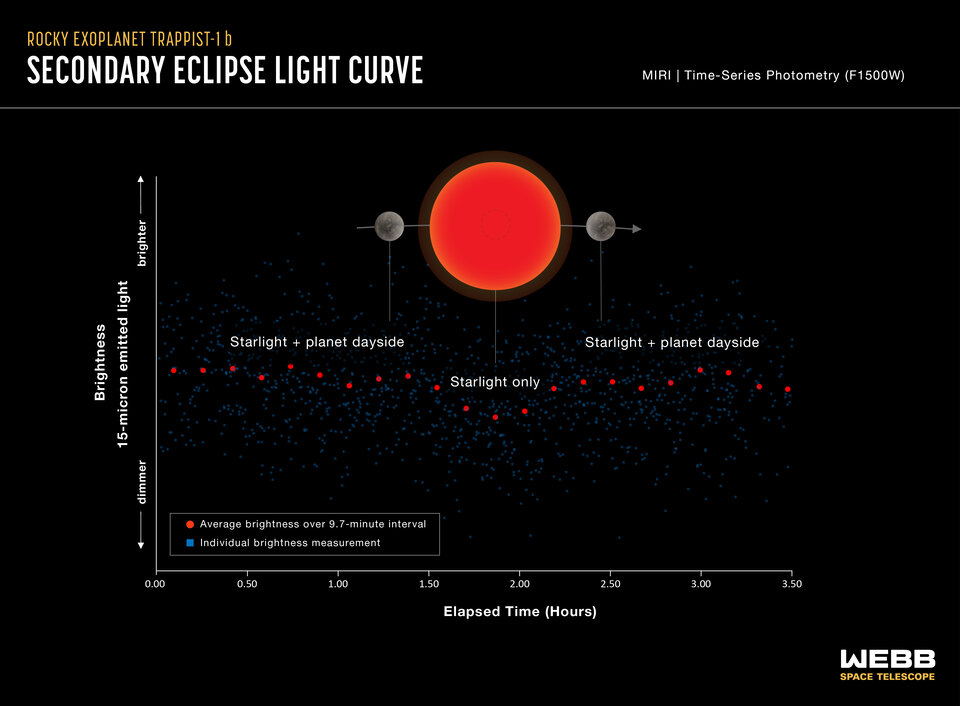With the James Webb Space Telescope’s ability to detect and study the atmospheres of distant planets orbiting other stars, exoplanet enthusiasts have been anticipating JWST’s first data on some of the worlds in the famous TRAPPIST-1 system. This is the system where seven Earth-sized worlds are orbiting a red dwarf star, with several in the habitable zone.
Today, a new study was released on the innermost planet in the system, TRAPPIST-1 b. The authors of the study were quite frank: this world very likely has no atmosphere at all. Additionally, the conditions there for possible life as we know it only get worse from there.
This world orbits so close to the star that it receives four times as much irradiation as the Earth receives from the Sun. Its dayside temperatures reach 500 kelvin, (roughly 230°C, or 450°F), which on the upside is the perfect temperature to bake a pizza.
All planets in the TRAPPIST-1 system have been observed previously with the Hubble and Spitzer Space Telescopes, and so far, no atmospheric features have been detected. But still, astronomers haven’t been able to rule out the possibility. With JWST’s infrared capabilities, it has the power to detect ‘heavy’ molecules such as carbon dioxide, oxygen, and methane, and so has the potential to determine whether or not the TRAPPIST-1 planets have atmospheres, and if so, what they are made of.
“These observations really take advantage of Webb’s mid-infrared capability,” said Thomas Greene, an astrophysicist at NASA’s Ames Research Center and lead author on the study published in the journal Nature. “No previous telescopes have had the sensitivity to measure such dim mid-infrared light.”

TRAPPIST-1 b, the innermost planet, has an orbital distance about one hundredth that of Earth’s, and so is not within the system’s habitable zone. Nor was it ever expected to have an atmosphere, due to the hellish conditions.
So, it wasn’t a surprise that they found virtually no detectable atmospheric absorption from carbon dioxide or other species. This is probably because TRAPPIST-1b absorbs nearly all the irradiation from the red dwarf star and does not have a high-pressure atmosphere.
But still, there was one more way to look for any traces of atmosphere, which is to measure the planet’s temperature.
Greene and colleagues used the JWST’s Mid-Infrared Instrument (MIRI), which can observe mid-to-long wavelength radiation, to assess the thermal emission of TRAPPIST-1b. According to their paper, they detected the planet’s secondary eclipse, which is when TRAPPIST-1b passes behind its star and were able to measure the planet’s dayside temperature. They explained:
“When the planet is beside the star, the light emitted by both the star and the dayside of the planet reach the telescope, and the system appears brighter. When the planet is behind the star, the light emitted by the planet is blocked and only the starlight reaches the telescope, causing the apparent brightness to decrease. Astronomers can subtract the brightness of the star from the combined brightness of the star and planet to calculate how much infrared light is coming from the planet’s dayside. This is then used to calculate the dayside temperature.”

This type of observation was in itself a major milestone, the team said. With the star more than 1,000 times brighter than the planet, the change in brightness is less than 0.1%.
“There was also some fear that we’d miss the eclipse. The planets all tug on each other, so the orbits are not perfect,” said Taylor Bell, a post-doctoral researcher at the Bay Area Environmental Research Institute who analyzed the data, quoted in a press release. “But it was just amazing: The time of the eclipse that we saw in the data matched the predicted time within a couple of minutes.”
The team said they hope to make more observations of TRAPPIST 1b, as they’d like to know more about the heat redistribution of the planet. Additionally, this observation can help inform future observations of the other TRAPPIST-1 planets –as well as the properties of other red dwarf planets — and how they differ from those in our own Solar System.
So, stay tuned for JWST data on the next world in the system; it looks like we’re going to get them one at a time.
The post Finally, JWST's Data on the First TRAPPIST-1 Planet. Survey Says? It Sucks appeared first on Universe Today.
from Universe Today https://ift.tt/w7SXyWe
via IFTTT
Comments
Post a Comment